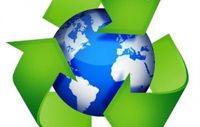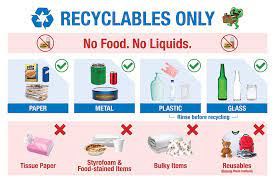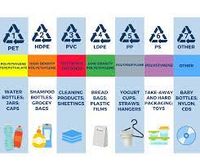Recycling
What Is Recycling?
You've probably heard someone like your parents or your teacher explaining the importance of recycling. You most definitely have seen the green or blue recycling containers with the three arrows on the side. But, what exactly is recycling?
Recycling is the process of taking materials ready to be thrown away and converting (changing) them into reusable materials.
This is important to reducing trash in the world's landfills, which pollute Earth's soil, water, and air. Recycling also helps preserve natural resources or materials that occur naturally and are used to make products - like when we use trees to make paper.
When we don't recycle and reuse, we risk depleting (using up) our natural resources.
Recyclable Materials If you were to look in your trash can, you would see that there are many different types of trash. Only certain materials can be recycled: glass, paper, plastic, and metal are the main recyclables, though some recycling centers will also take organics like banana peels and chicken bones.
How do you know what can be recycled? Well, many products that can be recycled will be stamped with the following symbol:
Which Plastic are recyclable?
7 Types of Plastic That Are Most Common
PETE or PET – Polyethylene Terephthalate
PET is the most common plastic material name nowadays. It’s used in mostly beverage bottles, oven – tray detergent and cleaning product bottles. It is also used for the finishing of objects such as liquid crystals, displays, carpets, clothes, guitars and pianos. Therefore, this material is suitable for recycling into filament, however, it absorbs odors and flavors from foods and liquids stored in it, which can prevent you from being able to recycle PET into filament. Furthermore, the plastic is designed for blow-molding, not extrusion (it does not flow easily inside an extruder).
HDPE – High Density Polyethylene
Another common plastic material is HDPE, it is known for having a low risk of leaching into foods and or liquids. This material is mostly used in the making of children toys, yogurt cups, milk jugs, shampoo bottles and other similar products. Recycled HDPE is mostly turned into pens, plastic lumber, plastic fencing, picnic tables, and bottles. This material is suitable for recycling into filament, however, it is not easy to turn into filament; it flows easily but requires special cooling.
PVC plastics contain very harmful chemicals that have been linked to various diseases. This material is usually used for the making of plumbing pipes, tiles, windows and medical equipment. Due to the fact that this material has harmful chemicals it is not recommended to recycle it yourself. PVC only gets recycled by specialized programs that recycle it into flooring, paneling and roadside gutters.
LDPE – Low-Density Polyethylene
This material is a very safe and clean plastic. It is recognized by its flexible and thin texture. It is commonly found in household items like grocery bags, plastic wraps, frozen food containers and food holding bottles. LDPE is recyclable but not recommended to recycle into filament, due to its behavior in molten state and the shape of the items it usually comes in (grocery bags being a good example of something painful to shred). Recycled LDPE is usually found back in garbage cans, paneling, furniture, flooring and bubble wrap.
Another known safe plastic is PP. This material has a sturdy texture and it commonly found back in tupperware, syrup bottles, medicine bottles and yogurt containers. It is also heat resistant as it is also used in making microwavable food containers. PP is suitable for recycling into filament (depending on the item you want to recycle), and it is usually recycled into heavy-duty items like pallets, ice scrapers, rakes and battery cables.
This material is your everyday plastic, it is found in beverage cups, plastic utensils, insulation, packing materials, egg cartons, and disposable dinnerware. Although, some would say that it is notorious for leaching and poor recyclability, we actually managed to recycle it into filament. PolyStyrene is the material we used in our recycling video’s and therefore, we can recommend you to recycle your PS objects into filament. However, it is a possibility that random PS items could react differently and therefore, work differently as well, Other / Miscellaneous Plastics
SPI – 7
is seen as all kinds of plastic that does not fall in the 1 to 6 category. Miscellaneous plastics are usually found back in nylon, baby milk bottles, sunglasses, computer casings, and compact discs. This is actually the most important category since it contains all of the interesting plastics. All of the cool engineering and high-performance ones would correspond to 7. It consists of an immense variety (Nylon6 and other types of nylon, PEEK, PEKK, PEI, TPU, PC, many more). This category is a lot harder to define, but there is a lot of potential.
No matter what plastic you choose (PEEK, PET,….), they each come in dozens of grades (versions). We might be able to extrude and print one LDPE, but not another one. The challenge with all commodity plastics (1 to 6, + a few in 7) is that the parts were originally injected. Injection-molding grades do not work well with extrusion. Moreover, despite which material, the recycling challenges are almost always the same, so is the methodology (purity of the batch, shredding to an even size, finding good settings,….). In other words, we can’t always predict how the recycling will go, but if it is doable, we will manage. Now that you know how to recognize the different types of plastic, we can move on to the next step, which is how to shred the plastic correctly to be able to extrude it.
Recycling Process
Due to the lack of access to basic recycling technologies and know-how, plastic waste can barely realize its potential as a valuable secondary raw material in manufacturing. Most often it gets incinerated or accumulates in landfills or the natural environment as waste – although the process itself is very easy and possible in small-scale:
Plastic waste gets :
collected,
sorted,
washed,
shredded into fine granules,
heated and pressed into a mould.
Through this simple process plastic waste gets transformed into new and useful products for local markets.
The process is divided into six steps:
1. Collecting & sorting
Plastic waste gets collected and sorted according to the different plastic types.
2. Washing & drying
It gets washed and dried to prepare it for the further processing steps.
3 Shredding
The sorted and cleaned plastic gets shredded into flakes of different sizes.
4. Injecting and/or extruding
Under pressure and with heat the melted flakes are injected/extruded into moulds.
5. Moulds
The aluminium or steel moulds are the negative forms of the new product.
6. Products
Plastic waste can be turned into almost any desired high-quality object.
Required Machines
1. Shredder
The Shredder is able to shred about 15 to 30 kg plastic waste per hour into fine granules. The knives can be adjusted to different types of plastics.
2. Injection Machine
The shredded granules are then put into the Injection Machine and are heated. With the right temperature and time they are then injected into the moulds.
3. Extruder
The granules can also be heated in the Extruder. The Extruder can be used for production of larger products such as beams, pipes and water gutters.
4. Air Filter
The rollable Air Filter serves as an additional machine to the Extruder and Injection Machine. It has flexible intake hoses and an integrated activated carbon filter.
Note!
Different plastic types should never be mixed as this will result in a significant decrease in quality standards and make it very difficult to recycle them in the future.
GMF - FOR A CLEAN ENVIRONMENT IN OUR FUTURE, WE EDUCATE OUR SCHOOLS EVERYTHING ABOUT THE EARTH POLLUTION








